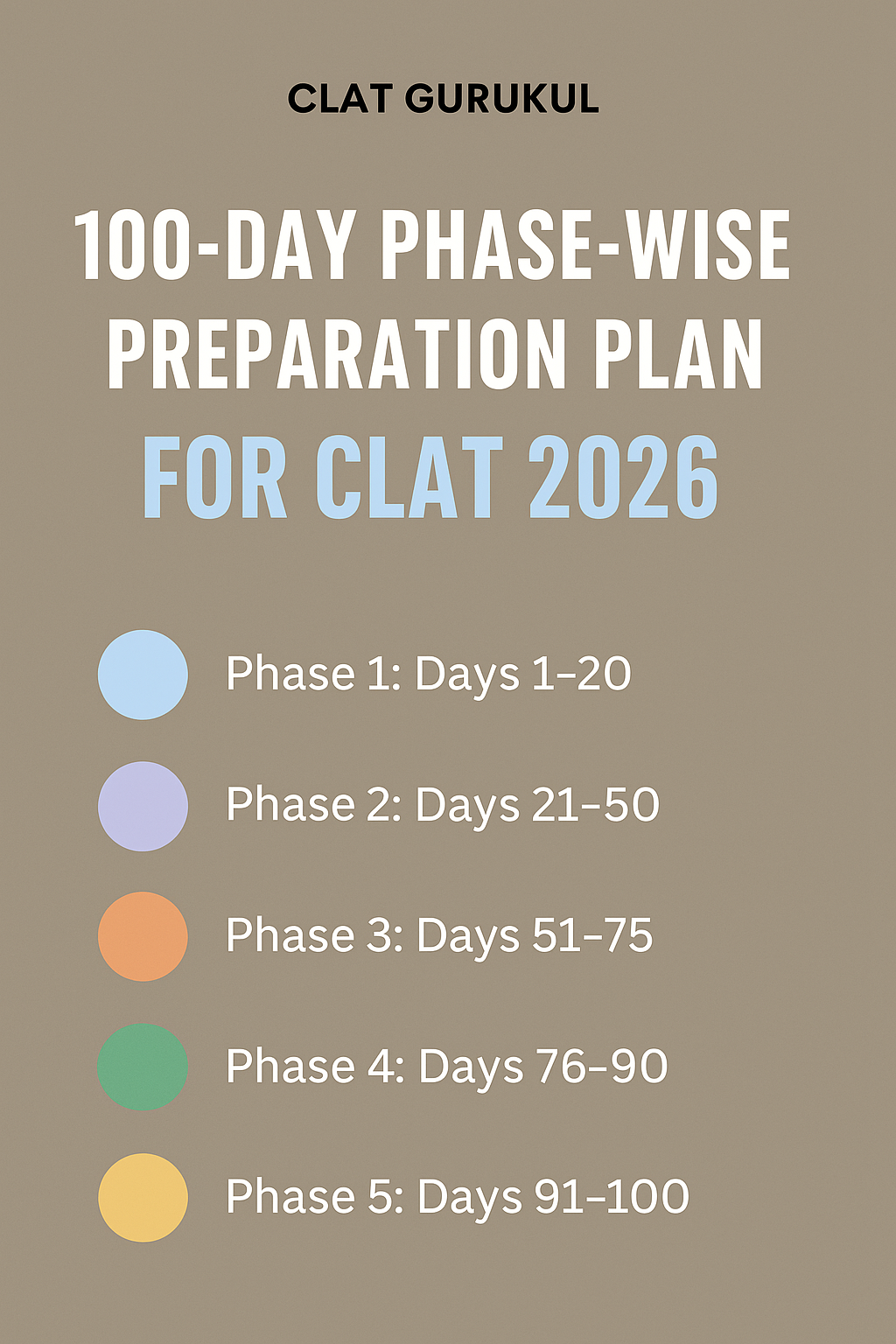Preparing for CLAT 2026 is both a challenge and an opportunity for aspiring law students. With just 100 days left, aspirants need a well-designed strategy to cover the entire syllabus systematically, practice rigorously, and enhance their speed and accuracy. A strategic approach not only ensures time management but also builds confidence, reduces stress, and maximizes exam performance. For students relying on online coaching for CLAT, following a structured 100-day plan will provide a clear roadmap to success.
Why a Well-Designed Strategy is Crucial
Structured Coverage of Syllabus
CLAT demands knowledge across multiple subjects including Legal Aptitude, Logical Reasoning, Quantitative Techniques, English Language, and General Knowledge.
Without a strategy, students may overlook critical areas, including recent laws and CLAT Current Affairs 2026, resulting in incomplete preparation.
Time Management
With only 100 days, efficient allocation of study hours is key.
A strategy ensures each topic receives adequate attention and helps balance preparation between stronger and weaker sections.
Regular Assessment and Feedback
Strategic planning integrates periodic mock tests and self-assessment.
This helps students identify mistakes, improve weak areas, and track progress effectively.
Integration of Current Affairs
GK and current events hold substantial weight in CLAT.
A strategic plan ensures students stay updated with Current Affairs 2026 and focus on high-probability topics for CLAT 2026.
Confidence and Stress Management
Random preparation often leads to stress and confusion.
Following a roadmap fosters confidence and ensures aspirants enter the exam hall with clarity and composure.

Phase-Wise 100-Day Plan for CLAT 2026
The 100 days are divided into five phases, each with clear objectives, focus areas, and actionable steps.
Phase 1: Days 1–20 – Foundation & Syllabus Familiarization
Objectives: Build a strong foundation, understand syllabus structure, and identify strengths and weaknesses.
Syllabus Mapping:
Go through the entire CLAT 2026 syllabus.
Divide topics into sub-sections for focused preparation.
Diagnostic Assessment:
Take an initial full-length mock test.
Identify weak and strong sections; note timing and accuracy.
Subject-Wise Strategy:
Legal Aptitude: Understand basic legal principles, key statutes, and landmark judgments.
Logical Reasoning: Practice simple puzzles, sequences, and reasoning sets.
Quantitative Techniques: Revise basic arithmetic, algebra, percentages, and data interpretation.
English Language: Focus on grammar rules, reading comprehension, vocabulary, and sentence rearrangement.
Current Affairs: Begin following daily newspapers and online portals for CLAT Current Affairs 2026.
Daily Time Allocation:
2 hours: Legal Aptitude
1.5 hours: Logical Reasoning
1 hour: Quantitative Techniques
1.5 hours: English Language
1 hour: Current Affairs & GK
Resources:
Leverage online coaching for CLAT for structured guidance and curated study material.
Maintain a daily notebook for Current Affairs 2026.
Phase 2: Days 21–50 – Intensive Practice & Sectional Strengthening
Objectives: Strengthen concepts, increase practice, and develop accuracy in each section.
Legal Aptitude:
Solve case-based questions daily.
Memorize important constitutional provisions and Supreme Court judgments.
Logical Reasoning:
Solve medium to difficult puzzles and reasoning sets.
Practice argument-based reasoning and multi-step deductions.
Quantitative Techniques:
Focus on problem-solving speed and shortcuts.
Practice previous years’ questions to understand recurring patterns.
English Language:
Daily comprehension exercises.
Work on vocabulary expansion and grammar accuracy.
Current Affairs:
Maintain a structured GK notebook, updating CLAT Current Affairs 2026 regularly.
Cover government policies, judicial updates, international events, and environmental issues.
Mock Tests & Analysis:
Take 1–2 sectional tests per week.
Analyze errors and focus on weaker areas.
Time Management:
Gradually increase study hours for weak areas.
Review each session to ensure retention.
Phase 3: Days 51–75 – Advanced Practice & Speed Enhancement
Objectives: Improve exam speed, attempt advanced questions, and integrate multiple topics.
Full-Length Mock Tests:
Take 2–3 full-length tests weekly under timed conditions.
Track performance metrics: accuracy, speed, and time per section.
Error Log:
Maintain a record of mistakes to prevent repetition.
Focus on recurring errors in Legal Aptitude, Logical Reasoning, and Quantitative Techniques.
Legal Aptitude:
Revise laws, landmark cases, and tricky problem-solving techniques.
Practice scenario-based questions frequently.
Logical Reasoning & Quantitative Techniques:
Attempt advanced puzzles and complex data interpretation sets.
Focus on multi-step reasoning for integrated problem-solving.
English Language:
Focus on speed reading, summarization, and inference-based comprehension.
Practice timed reading exercises to simulate exam conditions.
Current Affairs Consolidation:
Revise previous months’ Current Affairs 2026.
Attempt quizzes and flashcards to strengthen GK recall.
Sectional Timing Practice:
Set time limits for each section to improve speed and accuracy.
Phase 4: Days 76–90 – Revision & Mock Test Intensification
Objectives: Consolidate learning, strengthen weak areas, and refine exam strategy.
Comprehensive Revision:
Revise all key concepts, legal provisions, formulas, and vocabulary.
Focus on high-yield topics likely to appear in CLAT 2026.
Targeted Practice:
Identify weaker topics using mock test analytics.
Practice 2–3 hours daily on weak areas.
Current Affairs Mastery:
Consolidate CLAT Current Affairs 2026 notes.
Prioritize GK questions on national and international updates, recent government schemes, and legal developments.
Full-Length Mock Tests:
Take 3 full-length mocks weekly.
Analyze mistakes immediately and adjust strategies.
Time Management and Pacing:
Focus on finishing each section within allocated time.
Practice skipping difficult questions to maximize scoring efficiency.
Phase 5: Days 91–100 – Final Preparation & Exam Readiness
Objectives: Achieve exam readiness, reinforce confidence, and focus on final revisions.
Quick Revision:
Revise short notes and high-yield topics.
Focus on statutory provisions, landmark judgments, formulas, and vocabulary.
Final Mock Tests:
Take 2–3 final mock tests to simulate exam conditions.
Work on timing, accuracy, and stress management.
Current Affairs & GK:
Revise last-minute Current Affairs 2026 updates.
Ensure awareness of recent laws, government schemes, and international developments.
Mental and Physical Fitness:
Maintain regular sleep, light exercise, and stress-free routines.
Avoid over-cramming; focus on calm confidence.
Exam Strategy:
Prioritize easier questions first, then tackle difficult ones.
Use elimination and time-saving techniques in English and Logical Reasoning.
Additional Tips for Effective 100-Day CLAT Preparation
Consistency Over Quantity:
Regular, focused study sessions are more effective than sporadic long hours.
Balanced Preparation:
Allocate time proportionally to weaker and stronger sections.
Reliable Resources:
Follow online coaching for CLAT to gain structured guidance and practice material.
Refer to authentic resources for CLAT Current Affairs 2026.
Note-Making and Revision:
Maintain concise, organized notes for quick last-minute review.
Assessment and Feedback:
Regularly attempt mock tests and quizzes to track improvement and adapt strategies.
Strategic Time Allocation:
Dedicate more time to high-weightage sections while ensuring coverage of all topics.
Conclusion
The final 100 days before CLAT 2026 demand discipline, strategy, and focused practice. A phase-wise plan allows aspirants to build strong foundations, enhance accuracy and speed, integrate current affairs knowledge, and manage stress effectively


